Archives
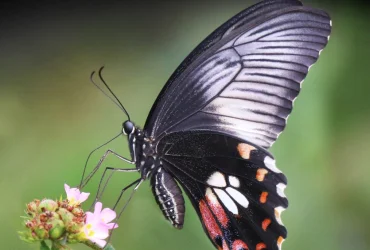 v10i2.256
v10i2.256ISSN: 1800-427X (printed)
eISSN: 1800-427X (online)
DOI:10.47605/tapro.v10i2.256
Submitted date: 25 July 2021
Accepted date: 26 October 2021
Published date: 22 November 2021
Pp. 84–88, pl. 17.
RELATIONSHIP BETWEEN PUPAL COLOUR AND SEX RATIO OF THE COMMON MORMON, Papilio polytes romulus CRAMER, 1775 (INSECTA: LEPIDOPTERA), SRI LANKA
D. Eranda. N. Mandawala* & P.A.D. Mokshi V. Perera
*Corresponding author. E-mail: nipunika001@gmail.com
Abstract
A free ranging female common Mormon (Papilio polytes romulus) butterfly was observed laying eggs on a Citrus aurantiifolia (Family: Rutaceae) plant in a home garden in Battaramulla. 16 eggs were collected and reared in the lab. The duration and measurements of each stage were recorded. After eclosion the sex and wingspan of all adult butterflies were recorded and they were released back to the wild. Pupae were observed in two colours: green and brown. Out of 16 pupae, 12 were green (75%) and four were brown (25%). The four brown pupae gave rise to two males (50%) and two females (50%). The 12 green pupae gave rise to 10 males (83%) and two females (17%). The sex ratios regardless of the pupal colour showed male dominance with 12 males (75%) and four females (25%). All four females were of the romulus form. A strong relationship between pupal colour and substrate texture was observed, but no relationship between pupal colour, sex and sex ratios was seen.
Key words : sex ratio, male dominance, Papilionidae, pupal colour, sexual dimorphism
Section Editor: Himesh D. Jayasinghe
eISSN: 1800-427X (online)
DOI:10.47605/tapro.v10i2.256
Submitted date: 25 July 2021
Accepted date: 26 October 2021
Published date: 22 November 2021
Pp. 84–88, pl. 17.
RELATIONSHIP BETWEEN PUPAL COLOUR AND SEX RATIO OF THE COMMON MORMON, Papilio polytes romulus CRAMER, 1775 (INSECTA: LEPIDOPTERA), SRI LANKA
D. Eranda. N. Mandawala* & P.A.D. Mokshi V. Perera
*Corresponding author. E-mail: nipunika001@gmail.com
Abstract
A free ranging female common Mormon (Papilio polytes romulus) butterfly was observed laying eggs on a Citrus aurantiifolia (Family: Rutaceae) plant in a home garden in Battaramulla. 16 eggs were collected and reared in the lab. The duration and measurements of each stage were recorded. After eclosion the sex and wingspan of all adult butterflies were recorded and they were released back to the wild. Pupae were observed in two colours: green and brown. Out of 16 pupae, 12 were green (75%) and four were brown (25%). The four brown pupae gave rise to two males (50%) and two females (50%). The 12 green pupae gave rise to 10 males (83%) and two females (17%). The sex ratios regardless of the pupal colour showed male dominance with 12 males (75%) and four females (25%). All four females were of the romulus form. A strong relationship between pupal colour and substrate texture was observed, but no relationship between pupal colour, sex and sex ratios was seen.
Key words : sex ratio, male dominance, Papilionidae, pupal colour, sexual dimorphism
Section Editor: Himesh D. Jayasinghe
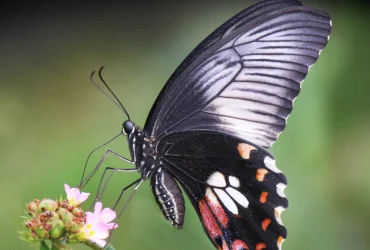 v10i2.255
v10i2.255ISSN: 1800-427X (printed)
eISSN: 1800-427X (online)
DOI:10.47605/tapro.v10i2.255
Published date: 22 November 2021
Pp. 80–83
EDITORIAL : A research priority for biodiversity conservation
Chris Margules
Deputy Editor: Taprobanica, the journal of Asian Biodiversity
Conservation biology emerged as a scientific discipline in the mid-1980s with the explicit practical goal of conserving species and habitats. The term ‘biodiversity’ was coined soon after, apparently at some time during the organization of the September 1986 National Forum on Biodiversity held by the US National Academy of Sciences and the Smithsonian Institution. The science of conservation biology was quickly taken up. Journals proliferated and textbooks soon followed. Laboratories within university biology and ecology departments specialized in conservation biology. Along with a great many other young biologists and ecologists, I climbed the moral high ground and set about research to help change the future by discovering how to protect biodiversity.
eISSN: 1800-427X (online)
DOI:10.47605/tapro.v10i2.255
Published date: 22 November 2021
Pp. 80–83
EDITORIAL : A research priority for biodiversity conservation
Chris Margules
Deputy Editor: Taprobanica, the journal of Asian Biodiversity
Conservation biology emerged as a scientific discipline in the mid-1980s with the explicit practical goal of conserving species and habitats. The term ‘biodiversity’ was coined soon after, apparently at some time during the organization of the September 1986 National Forum on Biodiversity held by the US National Academy of Sciences and the Smithsonian Institution. The science of conservation biology was quickly taken up. Journals proliferated and textbooks soon followed. Laboratories within university biology and ecology departments specialized in conservation biology. Along with a great many other young biologists and ecologists, I climbed the moral high ground and set about research to help change the future by discovering how to protect biodiversity.
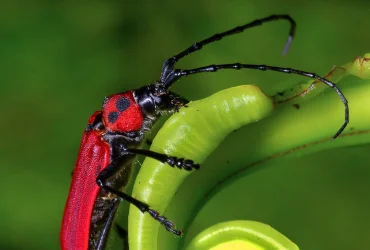 v5i1.103
v5i1.103ISSN: 1800-427X (print)
eISSN: 1800-427X (online)
DOI:10.47605/tapro.v5i1.103
Submitted date: 18 February 2013
Accepted date: 26 April 2013
Published date: 15 June 2013
Pp. 97–98.
A note on bird–habitat relationship in Kirala Kele, Sri Lanka
W.G.K.H. Samarasekara, E.P.S. Chandana* & N.J. de S. Amarasinghe
*Corresponding author. E-mail: epschandana@zoo.ruh.ac.lk
Wetlands and their associated biodiversity are threatened by habitat loss and fragmentation, invasive species, and global climate change. Knowledge of the bird distribution pattern with respect to the habitats is critically important in conservation and management of both birds and their habitats. Hence, an attempt was made to investigate the abundance and diversity of birds associated with selected habitats in the Kirala–Kele (K–K) marshland system with reference to the habitat characters between June 2010 and November 2010. K–K Eco touring zone is one such marshland type wetland situated in Matara, Southern Sri Lanka. It covers an area of about 1,800 ha of natural marsh areas and abandoned paddy fields. In this study K–K bird sanctuary was divided into five sites, differing in water retention and vegetation types, situated along the southwest – northeast trail at least 500 m apart from each other.
Section Editor: Varadarajan Gokula
eISSN: 1800-427X (online)
DOI:10.47605/tapro.v5i1.103
Submitted date: 18 February 2013
Accepted date: 26 April 2013
Published date: 15 June 2013
Pp. 97–98.
A note on bird–habitat relationship in Kirala Kele, Sri Lanka
W.G.K.H. Samarasekara, E.P.S. Chandana* & N.J. de S. Amarasinghe
*Corresponding author. E-mail: epschandana@zoo.ruh.ac.lk
Wetlands and their associated biodiversity are threatened by habitat loss and fragmentation, invasive species, and global climate change. Knowledge of the bird distribution pattern with respect to the habitats is critically important in conservation and management of both birds and their habitats. Hence, an attempt was made to investigate the abundance and diversity of birds associated with selected habitats in the Kirala–Kele (K–K) marshland system with reference to the habitat characters between June 2010 and November 2010. K–K Eco touring zone is one such marshland type wetland situated in Matara, Southern Sri Lanka. It covers an area of about 1,800 ha of natural marsh areas and abandoned paddy fields. In this study K–K bird sanctuary was divided into five sites, differing in water retention and vegetation types, situated along the southwest – northeast trail at least 500 m apart from each other.
Section Editor: Varadarajan Gokula
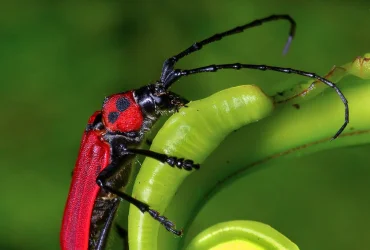 v5i1.102
v5i1.102ISSN: 1800-427X (print)
eISSN: 1800-427X (online)
DOI:10.47605/tapro.v5i1.102
Submitted date: 18 February 2013
Accepted date: 26 April 2013
Published date: 15 June 2013
Pp. 94–96.
Evidence of Saccolaimus saccolaimus (Chiroptera) roosting in a building in Sri Lanka
G.M. Edirisinghe, B.S.A.T.H. Sudasinghe* & Y. Mapatuna
*Corresponding author. E-mail: hsudasinghe@gmail.com
Sri Lanka is a critical area for global biodiversity conservation but rapid land–use changes endanger much of its fauna. Though understudied and under–estimated, bats are a critical component of Sri Lanka’s diversity. Comprising nearly one third of the overall terrestrial mammals of Sri Lanka, bats provide vital ecological and economic services. Sri Lanka has 30 species of bats that belong to 15 genera and seven families. Emballonuridae (Sheath– tailed bats) are widely distributed in the tropical and subtropical regions of the world. In Sri Lanka, there are three species of Emballonurids, Saccolaimus saccolaimus (Temminck, 1838), Taphozous longimanus Hardwicke, 1825 and Taphozous melanopogan Temminck, 1845. Phillips (1980) indicates that Saccolaimus saccolaimus, the Naked–rumped Pouched Bat was once common throughout the lowlands of both dry and the wet zones in Sri Lanka but less common in the highlands. However, now this species is considered to be extremely rare and was not recorded in an extensive five year survey conducted by Yapa & Ratnasooriya (2006) and has been missing from the Sri Lankan bat inventory for 75 years. It was re–discovered in 2011 at an estate in Kurunegala, Wayamba Province roosting in a hollow of a coconut tree. The previous record of this species is from Cheddikulam in 1936.
Section Editor: Judith Eger
eISSN: 1800-427X (online)
DOI:10.47605/tapro.v5i1.102
Submitted date: 18 February 2013
Accepted date: 26 April 2013
Published date: 15 June 2013
Pp. 94–96.
Evidence of Saccolaimus saccolaimus (Chiroptera) roosting in a building in Sri Lanka
G.M. Edirisinghe, B.S.A.T.H. Sudasinghe* & Y. Mapatuna
*Corresponding author. E-mail: hsudasinghe@gmail.com
Sri Lanka is a critical area for global biodiversity conservation but rapid land–use changes endanger much of its fauna. Though understudied and under–estimated, bats are a critical component of Sri Lanka’s diversity. Comprising nearly one third of the overall terrestrial mammals of Sri Lanka, bats provide vital ecological and economic services. Sri Lanka has 30 species of bats that belong to 15 genera and seven families. Emballonuridae (Sheath– tailed bats) are widely distributed in the tropical and subtropical regions of the world. In Sri Lanka, there are three species of Emballonurids, Saccolaimus saccolaimus (Temminck, 1838), Taphozous longimanus Hardwicke, 1825 and Taphozous melanopogan Temminck, 1845. Phillips (1980) indicates that Saccolaimus saccolaimus, the Naked–rumped Pouched Bat was once common throughout the lowlands of both dry and the wet zones in Sri Lanka but less common in the highlands. However, now this species is considered to be extremely rare and was not recorded in an extensive five year survey conducted by Yapa & Ratnasooriya (2006) and has been missing from the Sri Lankan bat inventory for 75 years. It was re–discovered in 2011 at an estate in Kurunegala, Wayamba Province roosting in a hollow of a coconut tree. The previous record of this species is from Cheddikulam in 1936.
Section Editor: Judith Eger
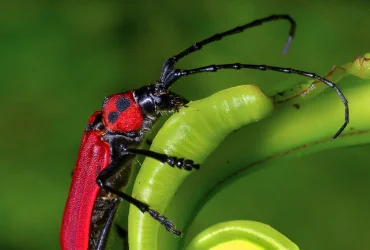 v5i1.101
v5i1.101ISSN: 1800-427X (print)
eISSN: 1800-427X (online)
DOI:10.47605/tapro.v5i1.101
Submitted date: 25 January 2012
Accepted date: 8 March 2013
Published date: 15 June 2013
Pp. 89–93.
Himalayan Yellow–throated Marten (Martes flavigula) in West Bengal, India
J.K. Mallick*
*Corresponding author. E-mail: jayantamallick2007@rediffmail.com
The nominate race of Martes flavigula Boddaert, 1785 (Mammalia: Carnivora: Mustelidae), popularly known as Himalayan Yellow–throated Marten, is the largest among the old world martens and has unique colour blends of black, white, golden–yellow and brown, relatively short fur and a long tail. It is distinguished from eight other recognized races of the species by the absence of a naked area of skin above the planter pad of the hind foot, a large mat of hair between the planter and carpal pads of the forefoot, and by its longer, more luxuriant winter coat. This study was initiated to (1) collect the past and contemporary locality records, (2) describe the natural history and ecology of the species, and (3) assess its conservation status in the hill forests of northern West Bengal, India.
Section Editor: Colin Chapman
eISSN: 1800-427X (online)
DOI:10.47605/tapro.v5i1.101
Submitted date: 25 January 2012
Accepted date: 8 March 2013
Published date: 15 June 2013
Pp. 89–93.
Himalayan Yellow–throated Marten (Martes flavigula) in West Bengal, India
J.K. Mallick*
*Corresponding author. E-mail: jayantamallick2007@rediffmail.com
The nominate race of Martes flavigula Boddaert, 1785 (Mammalia: Carnivora: Mustelidae), popularly known as Himalayan Yellow–throated Marten, is the largest among the old world martens and has unique colour blends of black, white, golden–yellow and brown, relatively short fur and a long tail. It is distinguished from eight other recognized races of the species by the absence of a naked area of skin above the planter pad of the hind foot, a large mat of hair between the planter and carpal pads of the forefoot, and by its longer, more luxuriant winter coat. This study was initiated to (1) collect the past and contemporary locality records, (2) describe the natural history and ecology of the species, and (3) assess its conservation status in the hill forests of northern West Bengal, India.
Section Editor: Colin Chapman
Hubungi Kami
The ultimate aim of the journal is to provide an effective medium for communication of the latest and best scientific information.
Copyright © 2020 Taprobanica. All Rights Reserved
Jasa Pembuatan Website by IKT




